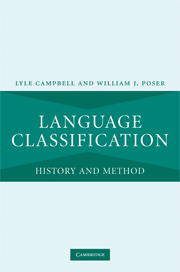Book contents
- Frontmatter
- Contents
- List of figures, tables, and charts
- Acknowledgments
- Preface
- 1 Introduction: how are languages shown to be related to one another?
- 2 The beginning of comparative linguistics
- 3 “Asiatic Jones, Oriental Jones”: Sir William Jones’ role in the raise of comparative linguistics
- 4 Consolidation of comparative linguistics
- 5 How some languages were shown to belong to Indo-European
- 6 Comparative linguistics of other language families and regions
- 7 How to show languages are related: the methods
- 8 The philosophical–psychological– typological–evolutionary approach to language relationships
- 9 Assessment of proposed distant genetic relationships
- 10 Beyond the comparative method?
- 11 Why and how do languages diversify and spread?
- 12 What can we learn about the earliest human language by comparing languages known today?
- 13 Conclusions: anticipating the future
- Appendix: Hypothesized distant genetic relationships
- References
- Index
7 - How to show languages are related: the methods
Published online by Cambridge University Press: 22 September 2009
- Frontmatter
- Contents
- List of figures, tables, and charts
- Acknowledgments
- Preface
- 1 Introduction: how are languages shown to be related to one another?
- 2 The beginning of comparative linguistics
- 3 “Asiatic Jones, Oriental Jones”: Sir William Jones’ role in the raise of comparative linguistics
- 4 Consolidation of comparative linguistics
- 5 How some languages were shown to belong to Indo-European
- 6 Comparative linguistics of other language families and regions
- 7 How to show languages are related: the methods
- 8 The philosophical–psychological– typological–evolutionary approach to language relationships
- 9 Assessment of proposed distant genetic relationships
- 10 Beyond the comparative method?
- 11 Why and how do languages diversify and spread?
- 12 What can we learn about the earliest human language by comparing languages known today?
- 13 Conclusions: anticipating the future
- Appendix: Hypothesized distant genetic relationships
- References
- Index
Summary
A man's foes, it has been said, are those of his own household. Comparative Philology has suffered as much from its friends as from its opponents.
(Sayce 1874–5:5)Introduction
Scholars appear to agree that a successful demonstration of linguistic kinship depends on adequate methods. Unfortunately, there is disagreement and confusion concerning what these methods are, and hence discussions of methodology frequently assume a central role in considerations of possible remote relationships. Given this state of affairs, it is important to appraise the various methodological principles, criteria, and rules of thumb, as well as pitfalls, relevant to investigating distant genetic relationships. That is the goal of this chapter. We provide guidelines for both framing and testing proposals of distant linguistic kinship, and we point out the frequent errors that need to be avoided. (In Chapter 9 we evaluate several of the more prominent hypothesized distant genetic relationships on the basis of the methods surveyed here.)
In practice, the successful methods for establishing distant linguistic affinity have not been different from those used to validate any family relationship, whether close or distant. The comparative method has always been the primary tool for establishing these relationships. Because the methods for investigating potential distant genetic relationships are not essentially different from those utilized to work out the history and classification of more closely related languages, this has resulted in a continuum from established and non-controversial families (e.g. Austronesian, Bantu, Indo-European, Finno-Ugric, Mayan), to more distant but solidly demonstrated relationships (e.g. Uralic, Siouan-Catawban, Benue-Congo), to plausible but inconclusive proposals (e.g. Indo-Uralic, Proto-Australian, Macro-Mayan, Niger-Congo), to doubtful but not implausible ones (e.g. Altaic, Austro-Tai, Eskimo–Uralic, Nilo-Saharan), and on to virtually impossible proposals (e.g. Basque–Na-Dene, Indo–Pacific, Mayan–Turkic, Miwok–Uralic, Niger–Saharan, and so on).
Information
- Type
- Chapter
- Information
- Language ClassificationHistory and Method, pp. 162 - 223Publisher: Cambridge University PressPrint publication year: 2008
Accessibility standard: Unknown
Why this information is here
This section outlines the accessibility features of this content - including support for screen readers, full keyboard navigation and high-contrast display options. This may not be relevant for you.Accessibility Information
- 1
- Cited by
